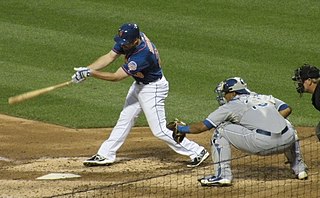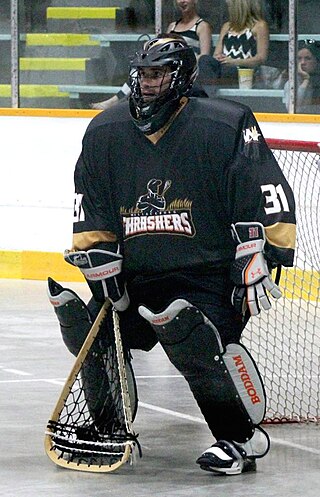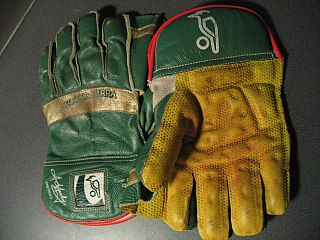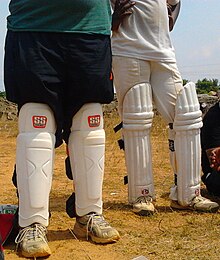
Fielding in the sport of cricket is the action of fielders in collecting the ball after it is struck by the striking batter, to limit the number of runs that the striker scores and/or to get a batter out by either catching a hit ball before it bounces, or by running out either batter before they can complete their current run. There are a number of recognised fielding positions and they can be categorised into the offside and leg side of the field. Fielding also involves trying to prevent the ball from making a boundary where four "runs" are awarded for reaching the perimeter and six for crossing it without touching the grass.

In many team sports that involve scoring goals, the goalkeeper is a designated player charged with directly preventing the opposing team from scoring by blocking or intercepting opposing shots on goal. Such positions exist in bandy, rink bandy, camogie, association football, Gaelic football, international rules football, floorball, handball, hurling, field hockey, ice hockey, roller hockey, lacrosse, ringette, rinkball, water polo, and shinty, as well as in other sports.

Catcher is a position in baseball and softball. When a batter takes their turn to hit, the catcher crouches behind home plate, in front of the (home) umpire, and receives the ball from the pitcher. In addition to this primary duty, the catcher is also called upon to master many other skills in order to field the position well. The role of the catcher is similar to that of the wicket-keeper in cricket.
A jockstrap, also a jock (male), jill (female), strap, cup, groin guard, pelvic protector (female), supporter, or athletic supporter, is an undergarment for protecting the scrotum and penis or vulva during contact sports or other vigorous physical activity. This article deals chiefly with the genital protective sports gear designed for the male body, colloquially known as a "jock".

A baseball glove or mitt is a large glove worn by baseball players of the defending team, which assists players in catching and fielding balls hit by a batter or thrown by a teammate. Gloves are traditionally made of leather; but today other options exist, such as PVC and synthetic leather.

Cricket clothing and equipment is regulated by the laws of cricket. Cricket whites, sometimes called flannels, are loose-fitting clothes that are worn while playing cricket so as not to restrict the player's movement. Use of protective equipment, such as cricket helmets, gloves and pads, is also regulated.

Sports equipment, sporting equipment, also called as sporting goods, are the tools, materials, apparel, and gear used to compete in a sport and varies depending on the sport. The equipment ranges from balls, nets, and protective gear like helmets. Sporting equipment can be used as protective gear or a tool used to help the athletes play the sport. Over time, sporting equipment has evolved because sports have started to require more protective gear to prevent injuries. Sporting equipment may be found in any department store or specific sporting equipment shops.

In ice hockey, the goaltender wears specialized goaltending equipment to protect themselves from the impact of the puck, and to assist in making saves. Ringette and rinkball goaltenders use the same equipment with some exceptions. This article deals chiefly with the sport of ice hockey.

Helmets in cricket were developed in the 20th century.

A shin guard or shin pad, is a piece of equipment worn on the front of an athlete's shin to protect it from injury. These are commonly used in sports including association football, baseball, ice hockey, field hockey, lacrosse, cricket and mountain bike trials. They are also used in combat sports and martial arts competitions including kickboxing, mixed martial arts, taekwondo, karate and professional wrestling. This is due to either being required by the rules/laws of the sport or worn voluntarily by the participants for protective measures.

Ball hockey is a team sport and an off-ice variant of the sport of ice hockey. The sport is also a variant of one of several floor hockey game codes but more specifically a variant of street hockey.

In ice hockey, players use specialized equipment both to facilitate the play of the game and for protection as this is a sport where injuries are common, therefore, all players are encouraged to protect their bodies from bruises and severe fractures.

Lacrosse gloves are heavily padded, protective gloves worn by men's lacrosse players. The gloves are designed to protect players' hands, wrists, and forearms from checks, or legal defensive hitting common in the sport. Gloves consist of thick padding on the back of the hand and forearm covered in leather or canvas material, and a palm area made of synthetic and mesh material. A goaltender's gloves may have extra padding for the thumb to protect against injury from shots. While NCAA collegiate rules require that men's gloves have palms covered, other leagues, including post-collegiate club lacrosse, the National Lacrosse League, Major League Lacrosse, and international play, permit players to cut out the palm area for greater grip and control of the lacrosse stick.

Cooper Canada Ltd. was a sporting goods and fine leather goods manufacturer based in Toronto, Ontario, Canada. In its heyday, the 1960s through to the 1980s, the company was Canada's leading producer of fine leathergoods, hockey, baseball and lacrosse equipment. The company pioneered team-coloured hockey equipment and the use of nylon, foam, and modern plastics in equipment manufacturing.

The use of personal protective equipment (PPE) is inherent in the theory of universal precaution, which requires specialized clothing or equipment for the protection of individuals from hazard. The term is defined by the Occupational Safety and Health Administration (OSHA), which is responsible for PPE regulation, as the "equipment that protects employees from serious injury or illness resulting from contact with chemical, radiological, physical, electrical, mechanical, or other hazards." While there are common forms of PPEs such as gloves, eye shields, and respirators, the standard set in the OSHA definition indicates a wide coverage. This means that PPE involves a sizable range of equipment. There are several ways to classify them such as how gears could be physiological or environmental. The following list, however, sorts personal protective equipment according to function and body area.

Personal protective equipment serves an integral role in maintaining the safety of an athlete participating in a sport. The usage and development of protective gear in sports has evolved through time, and continues to advance over time. Many sports league or professional sports mandate the provision and usage of protective gear for athletes in the sport. Usage of protective gear is also mandated in college athletics and occasionally in amateur sports.

The goaltender or goalie is a playing position in indoor or box lacrosse. More heavily armoured than a field lacrosse goaltender, since the invent of indoor lacrosse in 1931, the box lacrosse goalie has evolved into a much different position than its field lacrosse cousin.

Wicket-keeper's gloves are large gloves used in cricket and worn by the wicket-keeper of the fielding team, which protect the hands of the wicket-keeper when catching balls bowled by the bowler, hit by a batter or thrown by a fielder.




















